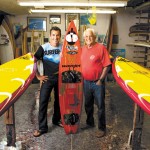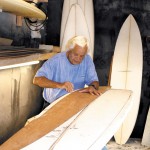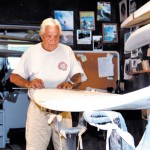Shaping History
Where would surfing be without pioneering surfer and board shaper Dick Brewer? It wouldn’t be nearly as much fun to do or to watch
Jodi Wilmott, veteran surf and watersports communications professional, told a crowd on Oahu’s north shore that Dick Brewer is the only person to have dominated a sport for more than 50 years. Although Brewer did surf, his passion is shaping surfboards that have been instrumental in shaping surfing history.
“Buffalo Keaulana was the King of Makaha, but he never won a contest,” says Dick Brewer of Oahu’s Makaha International that began in 1953. “After watching Mudd Warner out-surf Phil Edwards on his new Brewer, Keaulana asked me to build him a board.
- Where would surfing be without pioneering surfer and board shaper Dick Brewer? It wouldn’t be nearly as much fun to do or to watch
- Brewer with one of his handcrafted boards (Photo by Michael Mijares)
- Garrett McNamara and Dick Brewer with the board McNamara rode on the record-setting wave (Photo by Sherry Brewer)
- Brewer laying out his distinctive concave board bottom (Photo by Michael Mijares)
- Dick Brewer and Laird Hamilton with “Green Meanie,’ the Brewer board Hamilton rode on Teahupo’o and Jaws (Photo by Michael Mijares)
- Brewer is meticulous when laying out the shape of a new board (Photo by Michael Mijares)
“He won in ’62 when the waves were big and Buffalo had a Brewer. After that, Joey Cabell and Fred Hemmings won Makaha championships in succession on Brewers.”
At 76 years of age, Brewer’s eyes are clear, his mind is sharp and his passion is still shaping. We are in his home office, on Kaua’i’s North Shore. KKCR’s Surf Stories host Scott Mijares joins us. Posters and paintings of big wave surfers hang on the walls and Brewer sits in a chair made from a Brewer surfboard.
By the time Brewer was 15, he could run every machine in his father’s machine shop in Long Beach. He made remote control model airplanes into his late teens, one of which could go 90 miles per hour. After studying mechanical engineering at California State University-Long Beach, Brewer dropped out in his senior year and moved to Oahu. He opened Surfboards Hawaii in 1962 and began making custom surfboards.
With knowledge in airflow and dimensional analysis, Brewer’s innovative designs set the standard on short boards, concave bottoms and multiple fins. He won the 1971 Ala Moana Contest Senior Men’s Division on one of his three-fin boards.
“I was a machinist, where most of the shapers were carpenters,” says Brewer, who built his career on speed and drag. “I thought within 1/10,000 of an inch, where they thought within one-quarter of an inch.”
“That’s what makes him an artist,” says Mijares.
“He brings knowledge that very few shapers have.”
Teahupo’o is a reef break that was included on Transworld Surf’s list of the Top 10 Deadliest Waves.
Vetea David, aka Poto, became No. 3 in the world riding Brewers, and had successfully navigated the wave known as Chopu.
Brewer and Laird Hamilton became roommates on Oahu after Hurricane Iniki destroyed their homes. Across the street lived Darrick Doerner, owner of Designated Driver Inc., a water safety company that kept professional surfers safe during competitions and actors safe during Hollywood filming.
“Buzzy Kerbox (extreme water-sportsman, model and photographer) showed up with a Zodiac,” recalls Brewer, “and that’s when the three of them started tow-in surfing.
“I saw Laird ride a Billy Hamilton 9-foot, 8-inch gun and he covered so much water,” Brewer continues. “It was obvious that you could cover a lot more territory if you let go at a high rate of speed.”
Laird had his eye on Jaws, a big wave on Maui, and asked Brewer what kind of board he would need. Brewer modeled Laird’s board after Poto’s, which included reduced fin sizes and a full concave bottom.
“The cover of Jaws: Maui (by Charles Lyon) shows Laird riding the 30-foot wave for the first time,” says Brewer. “He caught air on the way down and he said as soon as he landed, he knew he was on Brewers for the rest of his life.”
Garrett McNamara, known for breaking the world record for the largest wave ever surfed and riding tidal waves from calving glaciers in Alaska, also rides Brewers. In November 2011, he rode a 6-foot Dick Brewer Tow Board into a 78-foot wave in Portugal and landed a spot in Guinness World Records.
“That was a fun ride and a lot more dangerous than other big waves I’ve ridden,” recalls McNamara during one of Mijares’ radio shows. “You gotta be on something that you can trust your life on, and Dick makes the magic board that you can trust your life on.”
In the early days, Brewer rode big waves at Waimea Bay on Oahu. At the time, riding a big, thick, heavy board was state-of the-art. He credits Buzzy Trent, one of surfing’s first big-wave pioneers, for saving his life.
“After the first few times I rode Waimea, Buzzy showed up at my house,” explains Brewer. “It was six o’clock in the morning and Buzzy says, ‘Get your gear, we’re going diving!’ Diving? I asked. He says, ‘Yeah, you wanna ride a 30-foot wave, you gotta spear fish at 30 feet.'”
For three months, Brewer and Buzzy went diving every morning, and the following winter Brewer was being filmed for the classic movie Endless Summer.
“It was one of the biggest waves in the movie and at that time, it was one of the biggest waves in history,” recalls Brewer. “I almost made the wave, but it caught up to me. I was down for two waves and as the second wave went over me, I came up and I was seeing stars. I thought, ‘Thanks Buzzy! You just saved my life.'”
Today, world-class surfers collaborate with Brewer before he makes one cut. As the client describes how the board will be used, Brewer draws it out. The cut is made, thickness is decided upon, and top, bottom and rail shapes are considered.
Even after 20 years, McNamara comes back to the shaping room with minor adjustments for new boards.
Bruce Irons, a professional surfer from Hanalei, says riding on a Brewer is natural. The pressure to perform was high. Irons’ board had spun out, and he needed one at the last minute to compete at Eddie Aikau Big Wave Invitational.
“Bruce picked up a Brewer 9-foot-7,” says Mijares. “Irons had never ridden one before, never been on surf that big, never been in The Eddie before, and he scored the best scores of his career.”
Irons won that 2004 competition on waves that exceeded 40 feet.
“Surfboard design is a constant flux of knowledge,” Brewer says. “This is the best time in history to live, because there’s more knowledge. In life, ignorance is darkness, knowledge is lightness.”








